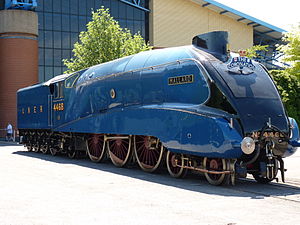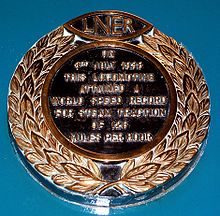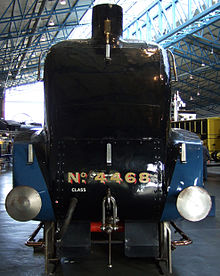- LNER Class A4 4468 Mallard
-
Mallard 
"Mallard" at the National Railway Museum at York. Power type Steam Designer Sir Nigel Gresley Builder LNER Doncaster Works Serial number 1870 Build date 3 March 1938 Configuration 4-6-2 UIC classification 2'C1'h3 Gauge 4 ft 8 1⁄2 in (1,435 mm) Leading wheel
diameter3 ft 2 in (0.965 m) Driver diameter 6 ft 8 in (2.032 m) Trailing wheel
diameter3 ft 8 in (1.118 m) Length 70 ft (21.34 m) Locomotive weight 102.95 long tons (104.6 t) Locomotive & tender
combined weight165 long tons (167.6 t) Boiler pressure 250 psi (1.72 MPa) Cylinders Three Cylinder size 18.5 × 26 in (470 × 660 mm) Top speed 126 mph (203 km/h) (529.4 rpm) Tractive effort 35,455 lbf (157.7 kN) Locomotive brakes Steam Train brakes Vacuum Career LNER, BR Class A4 Withdrawn 25 April 1963 Restored 1986 until 1988 Disposition Displayed at the National Railway Museum, York Number 4468 Mallard is a London and North Eastern Railway Class A4 4-6-2 Pacific steam locomotive built at Doncaster, England in 1938. While in other respects a relatively typical member of its class, it is historically significant for being the holder of the official world speed record for steam locomotives.
Mallard was designed by Sir Nigel Gresley as an express locomotive to power high-speed streamlined trains. Its wind-tunnel-tested,[1] aerodynamic body and high power allowed it to reach speeds of over 100 miles per hour (160 km/h). Mallard was in service until 1963, when it was retired, having covered almost one and a half million miles (2.4 million km).
It was restored to working order in the 1980s, but has not operated since, apart from hauling some specials between York and Scarborough in July 1986 and a couple of runs between York and Harrogate/Leeds around Easter 1987. Mallard is now part of the National Collection at the United Kingdom's National Railway Museum in York. On the weekend of 5 July 2008, Mallard was taken outside for the first time in years and displayed alongside her A4 sisters, thus reuniting all four A4s extant in the UK for the first time since preservation. She departed the museum for Locomotion, the NRM's outbase at Shildon on the 23 June 2010, where she was a static exhibit, until she was hauled back to York on 19 July 2011 and put back on display in its original location in the Great Hall.
The locomotive is 70 ft (21 m) long and weighs 165 tons, including the tender. It is painted LNER garter blue with red wheels and steel rims.
Contents
Record
Mallard is the holder of the official world speed record for steam locomotives at 126 mph (203 km/h). The record was achieved on 3 July 1938 on the slight downward grade of Stoke Bank south of Grantham on the East Coast Main Line, and the highest speed was recorded at milepost 90¼, between Little Bytham and Essendine. It broke the German (DRG Class 05) 002's 1936 record of 124.5 mph (200.4 km/h).
Mallard was the perfect vehicle for such an endeavour; one of the A4 class of streamlined locomotives designed for sustained 100+ mph (160+ km/h) running, it was one of a small number built with a double chimney and double Kylchap blastpipe, which made for improved draughting and better exhaust flow at speed; the remainder of the class were retro-fitted in the late 1950s. The A4's three-cylinder design made for stability at speed, and the large 6 ft 8 in (2.03 m) driving wheels meant that the maximum revolutions per minute was within the capabilities of the technology of the day. Mallard was five months old, meaning that it was sufficiently broken-in to run freely, but not overly worn. Selected to crew the locomotive on its record attempt were driver Joseph Duddington (a man renowned within the LNER for taking calculated risks) and fireman Thomas Bray.[2]
The locomotive had previously had problems with the big end bearing for the middle cylinder, so a "stink bomb" of aniseed oil was placed inside the big end, that would be released if it overheated. Shortly after the attainment of this record speed, Mallard suffered an overheated middle big end and had to limp back to Peterborough after setting the record. It then travelled to Doncaster for repair. This had been foreseen by the publicity department, who had many pictures taken for the press, in case Mallard did not make it back to Kings Cross. The Ivatt Atlantic that replaced Mallard at Peterborough was only just in sight when the head of publicity started handing out the pictures. Inaccuracies in the machining and setup of the Gresley-Holcroft derived motion (which derived the valve motion of the inside (middle) cylinder from those of the other two, avoiding a hard-to-maintain valve gear linkage between the frames) meant that the inside cylinder of the A4 did more work at high speed than the two outside cylinders; this overloading was mostly responsible for the failure.
Stoke Bank had a descending gradient of between 1:178 and 1:200. Mallard, with six coaches plus a dynamometer car in tow, topped Stoke Summit at 75 mph (121 km/h) and began to accelerate downhill. The speeds at the end of each mile (1.6 km) from the summit were recorded at: 87½, 96½, 104, 107, 111½, 116 and 119 mph (141, 155, 167, 172, 179, 187 and 192 km/h); half-mile (800 m) readings after that gave 120¾, 122½, 123, 124¼ and finally 125 mph (194, 197, 198, 200 and 201 km/h). The speed recorded by instruments in the dynamometer car reached a momentary maximum of 126 mph (203 km/h).
Rival claims
Mallard's world record has never been officially exceeded by a steam locomotive, though the German Class 05 was at least very close: in 1936, two years before Mallard's run, 05 002 had reached 200.4 km/h (124.5 mph) between Hamburg and Berlin. Unlike the LNER's long, straight, slightly downhill raceway of Stoke Bank, the 1936 run of the German Class 05 took place on a horizontal stretch of track (unlike world records for cars, there is no requirement for an average of two runs in both directions, and assistance from gradient or wind has always been acceptable in rail speed records). Also, unlike Mallard, 05 002 survived the attempt undamaged and did not even seem to be at its limit. Additionally, the Mallard's speed documentation is not beyond doubt, although most probably it did in fact reach the 124.5 mph (200.4 km/h) required to equal the German record.[3]
There are reports about higher speeds from North American steam locomotives, although none of these records was officially documented. Locomotives that may have exceeded the 126 mph (203 km/h) record include the Pennsylvania Railroad's S1 prototype which was unofficially clocked at 127.1 miles per hour, and the Milwaukee Road class F7. The Milwaukee Road had the fastest scheduled steam-powered passenger trains in the world. Both it and the Chicago & North Western (see CNW Class E-4) had timetables requiring running in excess of 100 mph (160 km/h); it is believed that both railroads' locomotives exceeded 120 mph (190 km/h).[4]
One fact that is often ignored when considering rival claims is that Gresley and the LNER had just one serious attempt at the record, which was far from a perfect run with a permanent way check through Grantham. Despite this a record was set.[5] Gresley planned to have another attempt in September 1939, but this was prevented by the outbreak of World War II.[6] Prior to the record run on 3 July 1938, it was calculated that 130 mph (210 km/h) was possible.[5]
Thus, Mallard still officially holds the record; plaques affixed to each side of the locomotive commemorate the feat.
1948 Locomotive Exchange Trials
In 1948, shortly after the formation of British Railways, the decision was taken to test locomotives from all of the former 'Big Four' companies to find the best attributes of speed, power and efficiency with coal and water. There were two ways of testing and comparing locomotives: either at the Rugby Locomotive testing plant, which was not ready until late 1948 or by testing in the field itself. The results of these trials would be used to help design the British Railways Standard design of locomotives.
The express passenger locomotive designs which would be compared were: London Midland Region (former LMS) Princess Coronation class, Eastern Region (former LNER) Class A4, Southern Region (former Southern) Merchant Navy class and Western Region (former GWR) 6000 Class or King class.
Three Gresley A4 locomotives were chosen to represent the Eastern Region: E22 Mallard, 60033 Seagull and 60034 Lord Farringdon. All of the locomotives had the Kylchap double blastpipe chimney arrangement and were fresh from Doncaster works. Mallard had emerged from Doncaster with a fresh coat of post-war garter blue livery, stainless steel numbers 22 with a small 'E' painted above them (for Eastern region), new boiler (her fourth) and third tender of her career.
E22 Mallard was used on 8 June 1948 on the Waterloo-Exeter route. Driver Marrable took the famous A4 with a load of 481 tons tare, 505 tons full, the same that had been used on the previous trip by 35018 British India Line. Mallard got through Clapham Junction in 6 minutes 57 seconds, Woking in 28 minutes 47 seconds. At Hook there were adverse signals, causing Mallard to slow to a crawl. Even so, by Axminster, Mallard had reached 82 miles per hour. Salisbury was reached in 108 minutes and 28 seconds. Despite the signals earlier, the train was only 5-and-a-half minutes late. The net time was 95.5 minutes.
Mallard failed after this trial and 60033 Seagull took over. 10 June saw Seagull achieve the run in 96 minutes 22 seconds, but had departed 3 minutes late, meaning Seagull had arrived with the same load 3.5 minutes early. For Mallard, the 1948 Locomotive Exchange Trials were over, but Mallard was to return to the Waterloo-Exeter line for a Locomotive Club of Great Britain (LCGB) railtour in 24 February 1963.
Technical specifications
Mallard was released into traffic for the first time on 3 March 1938. She was the first A4 to be fitted with a Kylchap double blast pipe from new. This was one of the factors that led to her selection for the attempt on the world rail speed record in the following July.
Mallard wore a variety of liveries throughout her career, these were: garter blue as 4468, LNER wartime black from 13 June 1942, later wartime black with the tender marked as "NE" from 21 October 1943 as 22 with yellow small stencilled numbers, post-war garter blue with white and red lining from 5 March 1948 with stainless steel cabside number 22, British railways dark blue as 60022 from 16 September 1949, brunswick green from 4 July 1952 and regaining her original LNER garter blue for preservation in 1963.
As with all 35 of the Gresley A4 pacific steam locomotives, Mallard was fitted with streamlined valances, or side skirting, when she was built. This was removed to ease maintenance in wartime, as it was on her sister engines. 4468 lost her valances during a works visit 13 June 1942, regaining them in preservation in 1963.
Mallard was fitted with twelve boilers during her 25 year career. These boilers were: 9024 (from construction), 8959 (from 4496 Golden Shuttle, 13 June 1942), 8907 (from 2511 Silver King, 1 August 1946), 8948 (from 31 Golden Plover, 5 March 1948), 8957 (from 60009 Union of South Africa, 16 September 1949), 29282 (from 60028 Walter K Whigham, 10 January 1951), 29301 (from 60019 Bittern, 4 July 1952), 29315 (from 60014 Silver Link, 23 April 1954), 29328 (new-build boiler, 7 June 1957), 29308 (from 60008 Dwight D. Eisenhower, 27 August 1958), 29310 (from 60009 Union of South Africa, 9 March 1960) and 27965 (from 60009 Union of South Africa, 10 August 1961).
Mallard has had seven tenders throughout her career. She started off with a non-corridor tender in 1938, had corridor design tenders during her British Railways days and was fitted with a non-corridor tender in 1963 to recreate her original appearance. The tenders she has been fitted with are: 5642 (3 March 1938 - 14 March 1939), 5639 (5 May 1939 - 16 January 1948), 5323 (5 March 1948 - 12 March 1953), 5648 (12 March 1953 - 21 July 1958), 5330 (27 August 1958 - 30 May 1962), 5651 (30 May 1962 - 25 April 1963) and 5670 (current tender, masquerading as original tender 5642).
Mallard was allocated to three sheds during her career: Doncaster, Grantham (transferring 21 October 1943) and Kings Cross ('Top Shed'), transferring on 11 April 1948.
Notes
- ^ Solomon, Brian (2003). "Fast Trains and Streamlined Pacifics". Railway masterpieces. Newton Abbot, England: David and Charles. p. 28. ISBN 9780715317433.
- ^ "Men who served on Mallard prepare to be reunited with famous locomotive". http://www.yorkshirepost.co.uk/news/Men-who-served-on-Mallard.4234814.jp.
- ^ Was German 05 002 The World's Fastest Steam Loco?
- ^ Fastest Steam Locomotive
- ^ a b Boddy, Neve & Yeadon 1973, p. 125
- ^ Boddy, Neve & Yeadon 1973, p. 126
References
- Allen, Cecil J. (1949). The Locomotive Exchanges 1870 - 1948. Ian Allan Ltd. A comprehensive book on locomotive exchanges, giving details of each trial and the locomotives involved.
- Boddy, M.G.; Neve, E.; Yeadon, W.B. (April 1973). Fry, E.V.. ed. Part 2A: Tender Engines - Classes A1 to A10. Locomotives of the L.N.E.R.. Kenilworth: RCTS. ISBN 0 901115 25 8.
- Clarke, David (2005). Locomotives in Detail: 3 Gresley 4-6-2- A4 Class. Ian Allan Publishing. ISBN 0-7110-3085-5. An overall history of the Gresley A4 class, as well as unparalleled details about the class and individual members.
- Yeadon, W.B. (2001). Yeadon's Register of LNER Locomotives: Volume Two: Gresley A4 and W1 classes. Booklaw/Railbus is association with Challenger. ISBN 1-871608-15-5. Histories of the A4 and W1 classes of locomotive with details of repairs and liveries etc.
External links
4464 Bittern • 4468 Mallard • 4488 Union of South Africa • 4489 Dominion of Canada • 4496 Dwight D Eisenhower • 4498 Sir Nigel GresleyCategories:- Individual locomotives
- Preserved London and North Eastern Railway steam locomotives
- Railway locomotives introduced in 1938
Wikimedia Foundation. 2010.




